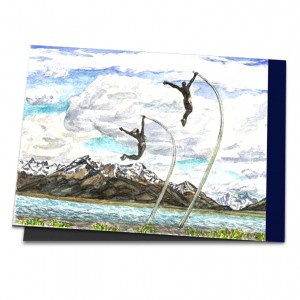Magnetic Bookmarks
- MAJOBA Color Magic
- New Motifs 2025
- Seaside
- Germany
-
Wide World
- Abu Dhabi
- Andorra
- Argentina
- Australia
- Austria
- Azores
- Belgium
- China (PRC)
- Costa Rica
- Crete
- Cuba
- Czech Republic
- Denmark
- Dominica
- Dubai
- Egypt
- El Hierro
- England
- France
- Gibraltar
- Hawaii
- Iceland
- Ireland
- Italy
- Croatia
- La Gomera
- Lanzarote
- Latvia
- Madeira
- Marocco
- Mexico
- Moorea
- Netherlands
- New Zealand
- Norway
- Oman
- Patagonia
- Poland
- Portugal
- Rangiroa
- Rapa Nui (Easter Island)
- Samoa
- Scotland
- Spain
- Sri Lanka
- Sweden
- Switzerland
- Tahiti
- Tasmania
- Tenerife
- Türkiye
- USA
- Cabo Verde
- Fidschi
- Leisure Time
- Flowers
- Animals
- Christmas
-
Search terms A-Z
- Agriculture
- airplanes
- Antiquity
- Art
- Artcraft
- Autumn
- Books
- Bridges
- Buildings
- Bunt
- Castles
- Caves
- Chairs
- Christmas
- Cities
- Clefs
- Cliffs
- Clocks
- Clouds
- Deserts
- Doors
- Fest
- Figures
- Fishing
- Fog
- Forest
- Fountain
- Fruits
- Games / toys
- Gardens
- Gates
- Glacier
- Graves
- Harbour
- History
- Huts
- Instruments
- Islands
- Lakes
- Lighthouses
- Literature
- Market
- Means of transportation
- Megalithen
- Mills
- Monuments
- Moon
- Mountains
- Museums
- Mushrooms
- Natural Events
- Night
- Objects
- Palms
- Park
- Paths
- People
- Personalities
- Places
- Plants
- Points of Interest
- Pumpkins
- Rain
- Rainbows
- Religions
- Rivers / Creeks
- Rocks
- Ruins
- Sculptures
- Seashells
- Ships_boats
- Shoes
- Situations
- Snow
- Sports
- Spring
- Stars
- Steps
- Stones
- Sun
- Sunrises
- Sunsets
- Sunumbrellas
- Swimmingpool
- Symbols
- Tables
- Technology
- Towers
- Trains
- Trees
- Two
- Vulcanos
- Waterfalls
- Waves
- Weltraum
- Wiesen
- Wind
- Wind generators
- Windows
- Winter
- Work
- Z-Malstile
- Motifs + their stories
- Booklets & Audio
- MAJOBA Sets
- Timeless Calendars
- Audio
- Stories Behind
- About the artist
- MAJOBA in the video
- MAJOBA on the spot
- Business customers
January 2019
- At the end of the world -

The end of the world always conjures up a name for me: Tierra del Fuego or, ‘the Land of Fire’. Smouldering volcanic cones, bubbling crater lakes? “None of this, but gigantic grass plains – without any trees or bushes,” I explained to my friend Susanne while we were sitting on her couch. – “That’s a pity, so not impressive at all then?” – “On the contrary,” I replied. On the table I spread out the 12 small watercolours I had painted in Tierra del Fuego and southern Patagonia – “Look, the penguins. And here, the little jagged iceberg,” I pointed to one of the pictures. “It floated on the edge of a meltwater lake and shone from its interior as azure blue as the summer sky over the Mediterranean Sea. If only I had had time to paint the glacier it once belonged to. It is so gigantic, oozing out from the heights of a distant mountain into the valley, like a lava flow, but frozen snow. Miles wide and towering at its edge. Simply impressive.” – “And this one, what is it?” Susanne took one of my pictures in her hand. “Is that a couple jumping through the air?” – “Yes, that’s a sculpture in Puerto Nateles. It stands by the sea. The two figures are huge, the whole structure has a gigantic height. Fascinating. Like the man and woman in the distance, jumping out into the wide world, into the sky or simply into life, almost a ‘defiance of everything’ in a land of vastness, silence and loneliness.” – “You mean, the fire of joie de vivre burns always and everywhere, even at the end of the world,” joked Susanne. I nodded, but I was thinking about this very special ‘instant painting at the sea’, smelling the clear air once again, feeling the cool breeze, clearly feeling the proximity to the Antarctic. Rough climate, inhospitable living conditions. What was the attitude towards life in this region like? At the beginning of the 20th century, the natives were completely wiped out by the settlers. Only in the ethnological museum in Berlin there is still a single audio recording of their traditional songs. I should listen to them. – “So, tell me then: why is Tierra del Fuego actually called ‘the Land of Fire’ when there are no active volcanoes?” Susanne pulled me right back out from my memory. “Well, when the first explorers arrived there with their ships, the natives warmed themselves with gigantic fires. That is the reason for the name Tierra del Fuego. It gives so much room for the imagination. Land of wind would be much more fitting or simply ‘the end of the world’.” I saw the long roads in front of me, the thousands of wild rabbits that crossed them, the herds of curious but shy guanacos at the roadside, the Caribbean blue mountain lakes in the large national park, the purple lupine fields and gnarled, wind-bowed trees. It was beautiful there in a very special, modest, almost intimate way. Entirely without noise, entirely without leaving behind large vestiges of life. So quiet, almost silent, seemingly dwindling, it can only be in Patagonia, in Tierra del Fuego and all ends of the world.

 MAJOBA on Facebook
MAJOBA on Facebook